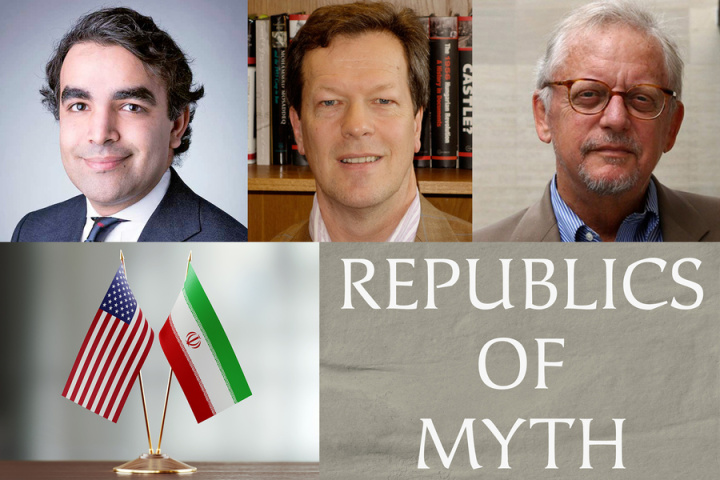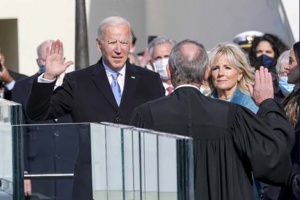When dueling narratives deepen a divide
At the latest Starr Forum, John Tirman and his collaborators describe the cultural framework that has worsened US-Iran relations.

At the latest MIT Starr Forum, the authors of the new book, “Republics of Myth: National Narratives and the U.S.-Iran Conflict,” talked about the difficulties in U.S.-Iran relations. From left to right: Hussein Banai, Malcolm Byrne, and John Tirman.
Image: Starr Forum & MIT News
For more than four decades, the U.S. and Iran have had a relentlessly poor relationship. To be sure, it is hardly a shock that tensions would run high between the countries following the hostage crisis of 1979-1981, when Iran held more than 50 U.S. diplomats in captivity for 444 days. Even so, little progress has been made in U.S.-Iran relations in subsequent years.
Why is this? One factor could be that the dominant stories framing each country’s politics combine to inhibit any kind of lasting cooperation with each other. That’s the thesis of a new book co-authored by John Tirman, executive director and a principal research scientist at the MIT Center for International Studies (CIS).
The book, “Republics of Myth: National Narratives and the U.S.-Iran Conflict,” just published by Johns Hopkins University Press, explores this joint history of identities at odds with each other. The authors identify key moments when U.S.-Iran tensions became further heightened and opportunities for détente dwindled.
Knowing these narratives is “fundamental to how we understand the confrontation that we have seen over the years,” Tirman said on Wednesday during the latest iteration of MIT’s Starr Forum, a public event series on international affairs.
Iran’s dominant national narrative, Tirman said, stems from the story of Imam Hussein, the prophet’s Mohammed’s grandson, who was killed by outsiders, thus giving Iran a “key story of noble sacrifice. Among other attributes, the narrative warns of foreign intrigue and betrayal.”
As for the U.S., Tirman suggested, “the master narrative of America derives from the myth of the frontier,” with expansion, wars, and the establishment of rule over others. Thus the U.S.-Iran conflict thus features one country which is “expansionist at its core,” pitted against another that is “deeply suspicious of foreign influence, demanding respect,” with little political space for leaders to deviate from these postures.
“The narratives have had this inimical effect on relations between the two countries,” Tirman said.
Missed opportunities
Hosted by CIS, the Starr Forum features talks by experts from inside and outside of MIT, about international relations and global politics.
At Wednesday’s event, Tirman was joined by both of his co-authors: Hussein Banai, an associate professor of international studies at the Hamilton Lugar School of Global and International Studies at Indiana University and a research affiliate at CIS; and Malcolm Byrne, deputy director and director of research for the nongovernmental National Security Archive, based at George Washington University. Byrne is also a research affiliate at CIS.
The book, the scholars noted, draws, in part, on input they received at a series of four conferences they helped organized in recent years, where officials who have been direct participants in U.S.-Iran relations detailed their experiences.
In their remarks, Tirman, Banai, and Byrne mentioned some of the key events that have further damaged U.S.-Iran relations since the hostage crisis ended, from the 1988 downing of a Iranian civilian airliner by the U.S. military, to the fact that Iran helped organize the 1996 Khobar Towers bombing of American military personnel (and civilians) in Saudi Arabia.
Byrne also listed “missed opportunities” to improve relations between the U.S. and Iran, including the period soon after the Iran-Iraq War ended in 1988. Another was the period soon after terrorist attacks of Sept. 11, 2001, given that Iran and Afghanistan’s Taliban regime were adversaries. In 2003, the U.S. received a proposal from Iran, via diplomatic intermediaries, suggesting a “grand bargain” with Iran involving nuclear security, a cessation of Iran’s support for terror activites, an end to sanctions, and more. It was never seriously pursued, however.
“The more we looked into this concept, and studied the history and dynamics of the relationship, it became clear that those missed windows in many cases had a connection to the more fundamental ideas of national narratives, that they could be explained by the impact of the belief systems that both sides held so closely,” Byrne said.
Those belief systems helped feed what Byrne called “the fundamental ignorance” that has hampered this bilateral relationship. Byrne stated that U.S. officials often regarded Iran’s decisions as indecipherable, and coming out of a “black box,” while Iranian leaders also failed to grasp U.S. goals. As he noted, one Iranian offer to reorient its backing for terror activities, away from American targets and toward Europe, was made without the understanding that it would still be highly unacceptable to the U.S.
Add in “the lack of formal communications channels” between the countries, Byrne said, and there has been “the persistence of a sense of distrust of the intentions of the other side,” with few ways to improve matters.
Nuclear security: The 2015 deal and its dismantling
For his part, Banai also emphasized that the cultural framework through which the U.S. and Iran view each other has greatly influenced high-level decision making.
“It’s very clear to us that the narrative that each government, each set of elites that are key players in maintaining this relationship, has curated over time, plays an enormously powerful role in conducting all sorts of direct, indirect, proxy relations between these two countries,” Banai said. As an example, he added, “The fact that the Islamic Republic [of Iran] is vociferous in its wish that the state of Israel disappear from the map of the Middle East [has] confirmed to the United States that this is a pariah, outlaw regime that has to be tamed; this is a frontier for the United States.”
At times, he noted, those perceptions can supercede what may be in the national interest of each country. The most noteworthy instance of cooperation between the U.S. and Iran in the last four decades came during the Obama administration, in the form of the Joint Comprehensive Plan of Action (JPCOA) in 2015, the treaty that limited Iran’s nuclear capabilities while lifting certain sanctions on Iran.
The Trump administration then withdrew from the JCPOA in 2018, “with gusto, and with the support of the entirety of the Republican Party and even some Democrats such as Chuck Schumer in the Senate as well,” Banai noted. The fact that the nuclear security deal would provoke such a quick policy backlash, Banai added, “really highlights in a very dramatic way how the exception ends up proving the rule.” That is, cooperation was soon replaced by mutual distrust again.
As matters stand, he added, any future acquisition of nuclear capability by Iran may prove the most difficult testing point of this entire fraught international relationship.
“It will put the two countries on a far different, perhaps alarming trajectory, because this narrative [would be] weaponized in a way we’ve never seen before,” Banai said.
Reprinted with permission of MIT News.


